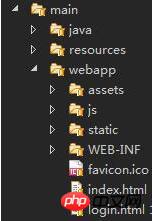
This article mainly brings you a Vue2.0 axios front-end and back-end login interceptor (explanation with examples). The editor thinks it is quite good, so I will share it with you now and give it as a reference for everyone. Let’s follow the editor to take a look, I hope it can help everyone.
After vue was updated to 2.0, the author announced that he would no longer update vue-resource, but recommended the use of axios. Some time ago, I used vue in a project for the first time. Regarding the login problem, I will write down my experience here.
First backend:
import org.springframework.web.servlet.handler.HandlerInterceptorAdapter;
import com.lovnx.gateway.po.User;
import javax.servlet.http.HttpServletRequest;
import javax.servlet.http.HttpServletResponse;
public class LoginInterceptor extends HandlerInterceptorAdapter{
@Override
public boolean preHandle(HttpServletRequest request, HttpServletResponse response, Object handler) throws Exception {
User user = (User)request.getSession().getAttribute("user");
if(user == null){
response.sendError(401);
return false;
}else
return true;
}
}The processing done here is: if there is no user in the session, a 401 error will be returned to the frontend.
Front end:
import Vue from 'vue'
import ElementUI from 'element-ui'
import 'element-ui/lib/theme-default/index.css'
import App from './App'
import router from './router'
import axios from 'axios'
// http response 拦截器
axios.interceptors.response.use(
response => {
return response;
},
error => {
if (error.response) {
if (error.response.status == 401) {
store.commit(types.LOGOUT);
router.replace({
path: 'login',
query: {redirect: router.currentRoute.fullPath}
})
}
}
return Promise.reject(error.response.data) // 返回接口返回的错误信息
}
);Note that the interceptor here is written in main.js.
//————————————–Separating line————————————–//
Of course, the above method The login page is written in the Vue project. Here is an example of using an independent login page combined with the Vue project.
Project directory:

The static and index.html are the things packaged by webpack.
The idea here should be combined with a previous blog post: Rewrite ajax to implement session timeout and jump to the login page
The general idea is: request any page, and the back-end interceptor intercepts it Request to check whether the user information in the session exists. If it does not exist, jump to this login.html; if it exists, respond to the data normally. Here we need to slightly change the front-end interceptor:
import Vue from 'vue'
import ElementUI from 'element-ui'
import 'element-ui/lib/theme-default/index.css'
import App from './App'
import router from './router'
import axios from 'axios'
// http response 拦截器
axios.interceptors.response.use(
response => {
//这个判断是关键,如果返回登陆页面内容了,就刷新当前页面,经后端处理就会跳转到登陆页面了
var temp = response.data + "";
if (temp.indexOf('lkdjoifdgjdfgjdfgjfh14546') > -1) {
router.go(0);
}
return response;
},
error => {
if (error.response) {
//退出登陆的时候就响应401即可
if (error.response.status == 401) {
router.go(0);
}
}
return Promise.reject(error.response.data) // 返回接口返回的错误信息
}
);Among them, lkdjoifdgjdfgjdfgjfh14546 is written in a hidden field of the login page.
Backend interceptor:
import org.springframework.web.servlet.handler.HandlerInterceptorAdapter;
import com.lovnx.gateway.po.User;
import javax.servlet.http.HttpServletRequest;
import javax.servlet.http.HttpServletResponse;
public class LoginInterceptor extends HandlerInterceptorAdapter{
@Override
public boolean preHandle(HttpServletRequest request, HttpServletResponse response, Object handler) throws Exception {
String requestUri = request.getRequestURI();
String contextPath = request.getContextPath();
if (requestUri.indexOf("/login.html") > -1 || requestUri.indexOf("/system/login") > -1) {
return true;
}
User user = (User)request.getSession().getAttribute("user");
if(user == null){
// 未登录跳转到login页面!");
response.sendRedirect(contextPath + "/login.html");
return false;
}else
return true;
}
}Related recommendations:
Vue-resource interceptor determines token failure and jumps
Vue interceptor vue-resource Detailed explanation of interceptor usage
Detailed explanation of WeChat applet development page interceptor
The above is the detailed content of Detailed explanation of Vue2.0 axios front-end and front-end login interceptor. For more information, please follow other related articles on the PHP Chinese website!




